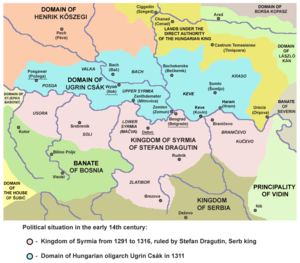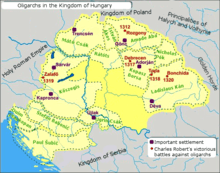Ugrin Csák

Ugrin Csák (Croatian: Ugrin Čak, Serbian: Угрин Чак; died in 1311) was a prominent Hungarian nobleman and oligarch in the early 14th century.
Ugrin Csák as an oligarch
In the beginning of the 14th century, after the last King of Hungary from the House of Árpád on the male line died in 1301 a brief period of interregnum followed. During this period, many Hungarian nobles assumed regal rights for themselves and gained power to the point of becoming oligarchs (powerful barons) and extended their local jurisdiction and influence over large territories, with their own private armies, administration and juristic systems. Some of them felt strong enough not to accept the rule of king Charles I of Hungary over them.
Still, Ugrin Csák, although he was one of these oligarchs, is considered to have been a very determined follower of the King.[1] He ruled over present-day region of Syrmia and parts of present-day regions of Slavonia and Bačka, and later also over part of Banat. His residences were in Újlak (Ilok) and Pozsega (Požega). After Ugrin Csák died, in 1311, the territory under his control was placed under direct control of king Charles I of Hungary. This extension of his personal territory, helped the king of the Kingdom of Hungary to defeat other local oligarchs.
See also
References
- ↑ Peter F. Sugar; Péter Hanák; Tibor Frank (1994). A History of Hungary. Indiana University Press. p. 37. ISBN 0-253-20867-X.
Sources
- Engel, Pál (1996). Magyarország világi archontológiája, 1301–1457, I [Secular Archontology of Hungary, 1301–1457, Volume I] (in Hungarian). História, MTA Történettudományi Intézete. ISBN 963-8312-44-0.
- Kristó, Gyula (1979). A feudális széttagolódás Magyarországon [Feudal Anarchy in Hungary] (in Hungarian). Akadémiai Kiadó. ISBN 963-05-1595-4.
- Kristó, Gyula (1999). "I. Károly király főúri elitje (1301–1309) [The Aristocratic Elite of King Charles I, 1301–1309]". Századok. Magyar Történelmi Társulat. 133 (1): 41–62.
- Markó, László (2006). A magyar állam főméltóságai Szent Istvántól napjainkig: Életrajzi Lexikon [Great Officers of State in Hungary from King Saint Stephen to Our Days: A Biographical Encyclopedia] (in Hungarian). Helikon Kiadó. ISBN 963-208-970-7.
- Szűcs, Jenő (2002). Az utolsó Árpádok [The Last Árpáds] (in Hungarian). Osiris Kiadó. ISBN 963-389-271-6.
- Zsoldos, Attila (2011). Magyarország világi archontológiája, 1000–1301 [Secular Archontology of Hungary, 1000–1301] (in Hungarian). História, MTA Történettudományi Intézete. ISBN 978-963-9627-38-3.
- Zsoldos, Attila (2012). "Hűséges oligarchák [Loyal Oligarchs]". In Baráth, Magdolna; Molnár, Antal. A történettudomány szolgálatában: Tanulmányok a 70 éves Gecsényi Lajos tiszteletére (in Hungarian). Magyar Országos Levéltár. pp. 347–354. ISBN 978-963-7228-34-6.
- Zsoldos, Attila (2013). "Kings and Oligarchs in Hungary at the Turn of the Thirteenth and Fourteenth Centuries". Hungarian Historical Review. 2 (2): 211–242.
External links
| Wikimedia Commons has media related to Ugrin Csák. |
- Map - Lands ruled by Ugrin Csák
- Map - Lands ruled by Ugrin Csák
- Map - Lands ruled by Ugrin Csák
- Map - Lands ruled by Ugrin Csák
- Map - Realm of Ugrin Csák (Sirmia) in Euratlas
Ugrin Born: c. 1240 Died: 1311 | ||
| Political offices | ||
|---|---|---|
| Preceded by Alexander, son of Drug |
Ban of Severin 1268 |
Succeeded by Lawrence, son of Kemény |
| Preceded by Nicholas Monoszló |
Master of the horse 1272–1273 |
Succeeded by Herbord Osl |
| Preceded by Paul Gutkeled |
Ban of Severin 1274–1275 |
Succeeded by Paul Gutkeled |
| Preceded by Matthew II Csák |
Voivode of Transylvania 1275 |
Succeeded by Ladislaus Kán |
| Preceded by Nicholas Geregye |
Judge royal 1275–1276 |
Succeeded by Mojs |
| Preceded by Ladislaus Kán |
Voivode of Transylvania 1276 |
Succeeded by Matthew II Csák |
| Preceded by Mikod Kökényesradnót |
Ban of Severin 1276 |
Succeeded by Paul Gutkeled (?) |
| Preceded by Ivan Kőszegi |
Master of the treasury 1277–1279 |
Succeeded by Lawrence Aba |
| Preceded by Albert Ákos (?) |
Ban of Macsó 1279 |
Succeeded by Elizabeth the Cuman Duchess of Macsó and Bosnia |
| Preceded by Egyed Monoszló |
Ban of Bosnia 1279 | |
| Preceded by Lawrence Aba |
Master of the treasury 1280 |
Succeeded by Lawrence Aba |
| Preceded by Nicholas Kőszegi |
Master of the treasury 1307–1309 |
Succeeded by Matthew III Csák |
